The Serengeti—just the name alone evokes images of sweeping savannahs, majestic lions, and the thunder of thousands of wildebeest on the move. But when is the best time to visit Serengeti National Park? The answer depends on what you’re hoping to see and experience. This guide gives you everything you need to know—from climate patterns and wildlife activity to tourist seasons and travel tips—so you can time your journey just right.
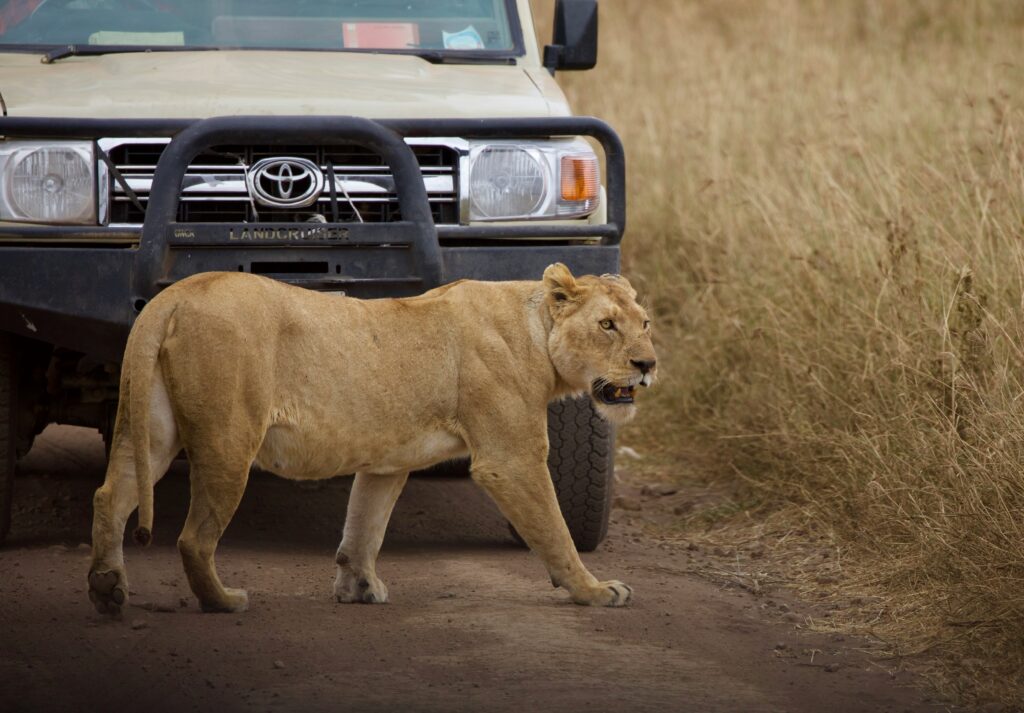
Introduction to Serengeti National Park
Overview of the Serengeti Ecosystem
The Serengeti is not just a park—it’s a vast, thriving ecosystem that spans approximately 30,000 square kilometers across northern Tanzania and into southwestern Kenya. Home to one of the world’s most extraordinary wildlife events—the Great Migration—the Serengeti teems with more than two million wildebeest, zebras, gazelles, and predators like lions, cheetahs, and leopards.
The word “Serengeti” itself comes from the Maasai language, meaning “endless plains.” And it’s fitting—imagine golden grasslands stretching as far as the eye can see, dotted with acacia trees, rocky kopjes, and riverine forests. This diverse landscape supports rich biodiversity, making it a UNESCO World Heritage Site and a premier safari destination.
Why Serengeti Is a Must-Visit
The Serengeti isn’t just about animal sightings—it’s about stepping into a documentary-like reality where every day holds a surprise. From witnessing dramatic predator-prey interactions to peaceful moments like a sunrise over the savannah, it’s a place that leaves a mark on your soul.
For those who dream of authentic African safaris, Serengeti checks every box. Whether you’re a first-timer or a seasoned explorer, the park’s sheer scale and richness never disappoint. Plus, with expertly curated experiences from Regal Tracks Safaris, you can tailor your adventure to fit your style—be it luxury, mid-range, or budget-friendly.
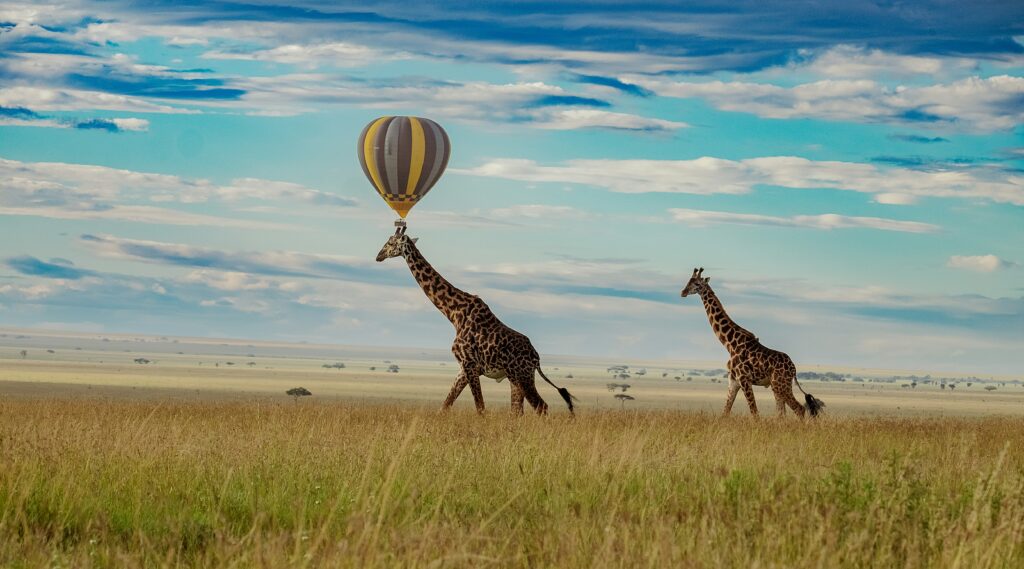
Understanding the Serengeti Climate
Serengeti Weather Patterns by Season
If you’re wondering when to go, understanding Serengeti’s weather patterns is the first step. The region experiences two main seasons: the dry season (June to October) and the wet season (November to May). But within those, there are nuances.
- Dry Season (June to October): This is the most popular time for tourists, thanks to clear skies, minimal rainfall, and prime wildlife viewing conditions. Animals gather around rivers and waterholes, making sightings easier and more dramatic.
- Wet Season (November to May): Split into short rains (November to December) and long rains (March to May), this period transforms the landscape into a lush green paradise. It’s also birthing season for many species, and birdwatching becomes exceptional.
Each season offers something unique. Whether it’s the raw intensity of a lion hunt in the dry months or the miracle of new life in the rains, the Serengeti is always alive.
Temperature & Rainfall Overview
Temperatures in the Serengeti are surprisingly mild, considering it’s in East Africa. Days typically range from 25°C to 30°C (77°F to 86°F), while nights can dip to 14°C (57°F), especially in the dry season. Rainfall varies dramatically between seasons:
| Month | Avg. Temp (°C) | Rainfall (mm) | Season Type |
|---|---|---|---|
| Jan | 27 | 90 | Short Rains End |
| Apr | 26 | 200 | Long Rains |
| Jul | 25 | 10 | Dry Season |
| Oct | 28 | 40 | Dry Season Ending |
Peak Season vs. Low Season
What to Expect in Peak Season (June to October)
If you’re hoping for crystal-clear game drives, large herds at watering holes, and iconic river crossings during the Great Migration, the peak season is your best bet. Spanning from June to October, this dry stretch offers the most consistent conditions for photography and animal tracking.
- Pros:
- Best time for predator action
- River crossings in July–August
- Minimal rain means better roads and visibility
- Cons:
- Higher prices for lodges and camps
- More tourists at popular viewpoints
But don’t let the word “crowded” scare you—thanks to the Serengeti’s size, even during peak times, you can find quiet corners with expert guides from Regal Tracks Safaris.
Pros and Cons of Low Season (March to May)
The long rains bring a different kind of magic. While roads can get muddy, and visibility may be reduced by tall grass, this is also when you’ll find vibrant greenery, fewer tourists, and fantastic birdlife.
- Pros:
- Lowest accommodation prices
- Lush, scenic landscapes
- Fewer vehicles—more intimate safaris
- Cons:
- Some camps may close due to road inaccessibility
- Difficult wildlife spotting in tall grass
Still, if you’re after an affordable, serene escape, low season might just surprise you. Visit our curated tour packages tailored for every season.
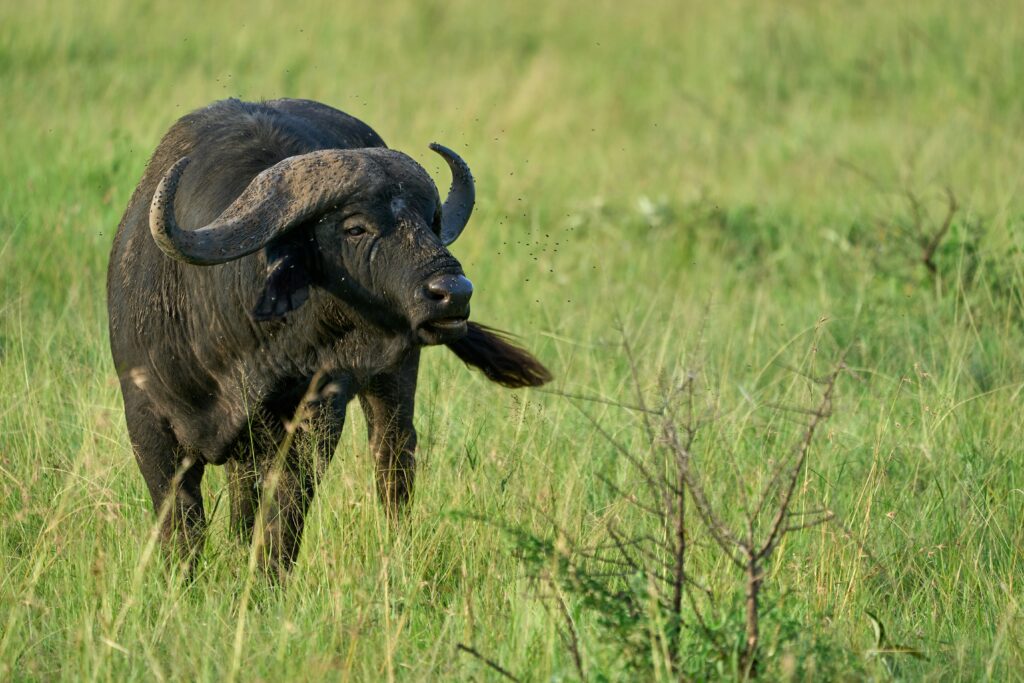
The Great Migration: A Natural Wonder
Best Months to Witness the Wildebeest Migration
Arguably the most famous event in Serengeti, the Great Migration is nature’s theater at its finest. Over two million wildebeest, along with zebras and gazelles, follow the rains in a continuous cycle from the southern Serengeti up to the Maasai Mara in Kenya.
Here’s a general guide:
- January–March: Calving season in the southern Serengeti—newborns and predators abound.
- April–June: Herds start moving northwest.
- July–August: Mara River crossings—expect dramatic scenes of survival.
- September–October: Herds linger in the northern Serengeti.
- November–December: They return southward.

Month‑by‑Month Guide to Visiting Serengeti
January to March: Calving Season in Ndutu & South Serengeti
From January through early March, the southern ecosystem around Ndutu buzzes with activity as approximately half a million wildebeest calves are born within a few weeks. This dramatic birth pulse draws predators like lions, hyenas, and cheetahs—making it one of the most intense wildlife spectacles of the year.
Wildlife Action: Ideal time to see newborn calves, stalking predators, and abundant scavenger activity.
Birding: Migratory and resident bird species converge—perfect for avid birdwatchers.
Crowds & Rates: Moderate traffic from tourists, with lower prices compared to peak dry season. This is a shoulder season, offering better value and quieter game drives.
April to June: Green Season & Western Serengeti Movement
As the long rains taper off in April and May, the southern plains transform into a lush, vibrant carpet of grasses. Herds begin their journey northwest, passing through the Western Corridor (Grumeti and Mbalageti Rivers):
- Wildlife Behavior: Wildebeest migration spreads across Western Serengeti; predators continue to follow.
- Scenery & Atmosphere: Verdant landscapes, fewer vehicles, and peaceful surroundings.
- Accommodation Notes: Many camps in Ndutu or Western Corridor behave as excellent launch points. Some central Serengeti lodges remain within 1–1.5 hours of herds.
This period offers an excellent balance: dramatic scenery, active migration, and lower costs.
July to October: Dry Season & Migration River Crossings
This is Serengeti’s peak time, aligning with the dry season, which runs from June through October:
- April–June: Herds move into Western Corridor, making Grumeti river crossings.
- July–September: Herds reach the northern Serengeti and begin the iconic Mara River crossings. The most dramatic river crossing events and predator-prey dynamics happen now.
- October: Herds drift east within Northern Serengeti, eventually crossing back into Tanzania if in Kenya.
✅ Why visit during this time:
- Wildlife congregates around dwindling water sources, making sightings easier.
- Vegetation is sparse, enhancing visibility.
- River crossings (Grumeti, then Mara) provide unforgettable, cinematic moments.
- Minimal rain, fewer mosquitoes, and improved road access.
⚠️ Be mindful: this is also the most crowded period, and accommodation rates peak. Book early.

November to December: Short Rains & Herds Return South
In November, the short rains bring the migration back from the northern plains into eastern and southern Serengeti:
- Migration Flow: Herds return via Eastern Serengeti and Lobo region, then gradually move south to Ndutu/Ngorongoro.
- Experience: Green, fresh grasslands and returning wildlife; fewer travelers and moderate pricing.
- Best Areas to Base: Central Serengeti, or camps between Lobo and southeast Serengeti—still within reach of herds.
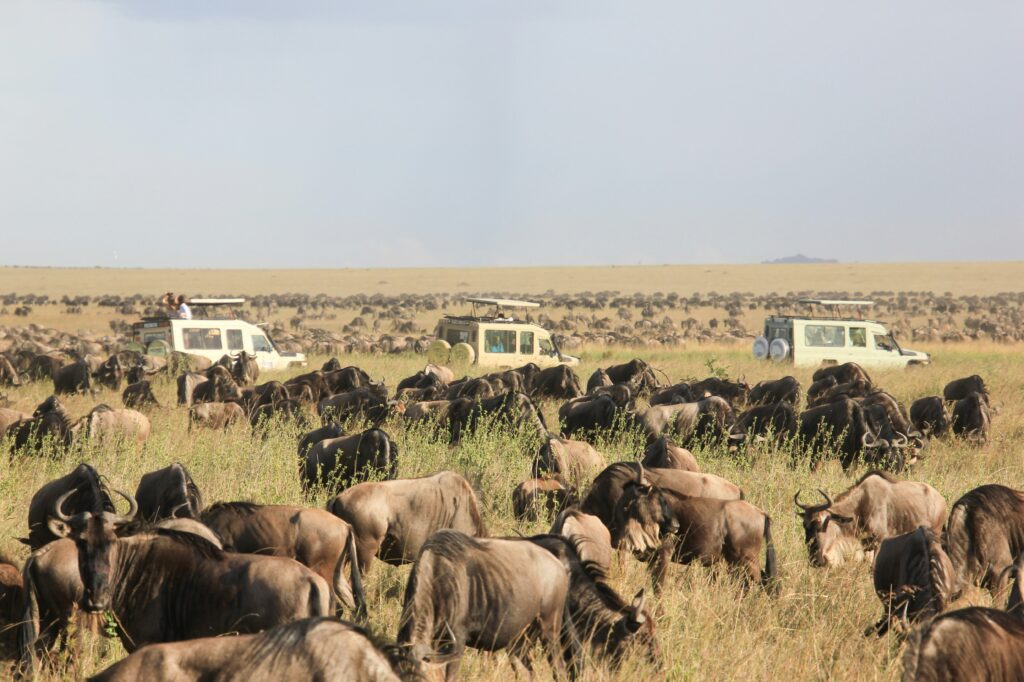
Choosing the Right Safari Experience
Budget vs Luxury Safaris
Whether you’re backpacking or indulging in high-end luxury, Serengeti has options:
- Budget / Mid-range: Mobile camps or modest lodges often open during migration peaks. Lower cost, but still comfortable.
- Luxury: High-end lodgings offer exclusive views, fine dining, cultural experiences, and experienced guides—even during peak season.
- Mobile Migration Camps: These tented camps follow the herd patterns, offering flexibility depending on migration timing.
You can easily tailor your safari with our safari packages, ranging from budget to luxury.
Customizing Your Tour With Regal Tracks Safaris
At Regal Tracks Safaris, we specialize in designing itineraries aligned with wildlife calendars, your travel preferences, and budget. Whether you want to catch the calving season in Ndutu or river crossings in North Serengeti, just click on visit our affordable tour packages or contact us for tailored help.
Wildlife Spotting Throughout the Year
Iconic Animals and When You’ll See Them
Big Cats: Predators follow the herds. Lion, leopard, and cheetah are often visible year-round, but encounters peak during dry season when prey is concentrated.
Calves & Predators: January–March is prime time for birth and predator-action.
River life: Watch crocodiles at Grumeti and Mara during June–September migrations.
Elephants, buffalos, giraffes: Resident wildlife visible throughout.
Birdwatching Opportunities
From November through April, birding is exceptional—many migratory species arrive, including storks, swallows, and raptors. The lush green season offers high activity and vibrant plumage displays.
Tips for Planning Your Trip
Booking in Advance
- Peak Months (July–Aug–Sept): Book 12+ months ahead to secure best lodges and river-crossing views.
- Shoulder / Low Seasons: Book at least 3 – 6 months in advance to ensure availability and the best rates.
What to Pack Based on Season
- Dry season: Layered clothing for cool mornings/evenings, sunscreen, wide-brimmed hat, and high-SPF mosquitos repellant.
- Rainy season: Waterproof jacket, quick-dry clothing, sturdy footwear, insect repellent, and gaiters for muddy terrain.
How to Get to Serengeti
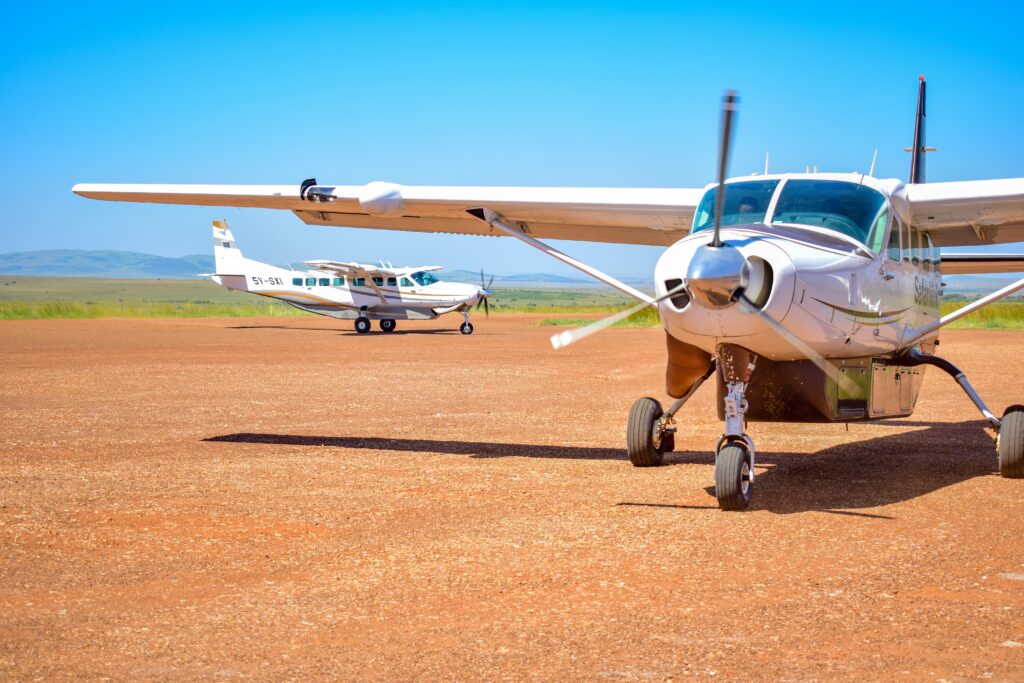
Nearest Airports & Regional Travel
Most visitors start in Arusha or Kilimanjaro. You can choose:
- Fly-in: Light aircraft transfers to Seronera, Ndutu, Lobo, or Kogatende airstrips—fast and convenient.
- Road Transfer: Overland safari from Arusha, passing through Tarangire and Ngorongoro before reaching Serengeti.
Both options can be seamlessly arranged through our tour packages and airport transfer services.
Where to Stay in Serengeti
Types of Accommodation
- Permanent Lodges: Solid structures located mainly in central and western regions.
- Seasonal/Mobile Tents: Move with the herds—ideal for migration season.
- Luxury Camps: High-end, eco-sensitive, and positioned strategically near key wildlife areas.
Best Regions Based on Season
- January–March: Ndutu or South Serengeti.
- April–June: Central or Western Serengeti.
- July–September: Northern Serengeti (Kogatende, Lamai, Mara River Camp).
- November–December: East or Southeast Serengeti near Lobo/Naabi.
We recommend exploring accommodation suites tailored to each migration season via our safari packages.
Experiencing the Culture Around Serengeti
Maasai Community Visits
Add depth to your safari by visiting Maasai villages, observing traditional life, witnessing cultural dances, or buying local handicrafts directly from community artisans.
Cultural Insights and Local Tours
Combine wildlife with human stories—guided experiences highlight Maasai traditions, local conservation projects, and community-run enterprises.
Common Mistakes to Avoid
Ignoring seasonal variation: Not all times deliver the same animals or scenery.
Under‑booking peak periods: This leads to higher prices and limited lodge availability.
Expecting predictable migration: Herd movements depend on rainfall and grass growth—timings can vary by weeks.
Overpacking or under‑planning: Be realistic about terrain and weather changes.
Choosing camps based only on price: Location relative to herds is critical.
Summary: When Should You Visit?
| Your Goal | Best Time to Visit | Why This Fits |
|---|---|---|
| Iconic Mara‑River crossings | July–September | Dramatic crossings, dense wildlife, dry-clear skies |
| Calving season & predator action | January–March | Newborns & predation in lush Ndutu region |
| Green landscapes, low crowds, affordability | April–May or November | Budget-friendlier, lush scenery, fewer tourists |
| All‑round wildlife & easy viewing | June, October, early November | Dry enough for clear skies with fewer tourists |
Conclusion
The best time to visit Serengeti National Park depends on what matters most to you. If you’re after epic river crossings and prime predator action, plan your trip during the dry season (June–October). Want lush scenery, newborns, and better value? Try January–March or the shoulder months in April–May and November. No matter when you go, Serengeti delivers unforgettable encounters—just match your interests with the right timing.
Need help customizing your itinerary or looking for a package that fits your budget and timeline? Feel free to contact us or explore our affordable safari packages.
FAQs
- When is the Serengeti least crowded?
March–May (long rains) and November–mid‑December (short rains) have fewer tourists and lower prices. - Can I see the Great Migration any time of year?
While some stages occur year-round, the best months are January–March (calving) and July–September (river crossings). - Which season is best for birdwatching?
November through April features peak migratory bird presence and lush green habitats ideal for birders. - Are roads passable during the rainy season?
Some routes become muddy and difficult, though many safari operators use 4×4 vehicles. Choose accommodations with access (e.g., Ndutu or Western Corridor). - How many days do I need for Serengeti safari?
A minimum of 3–4 nights is recommended, especially during migration periods, to increase chances of witnessing major events like river crossings.